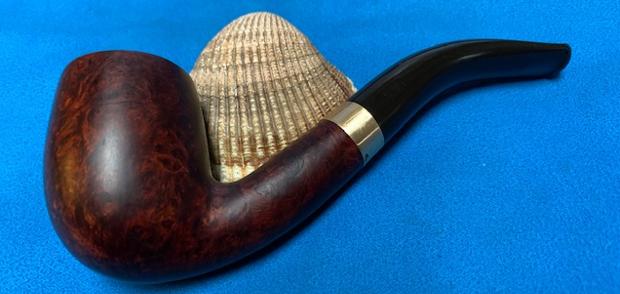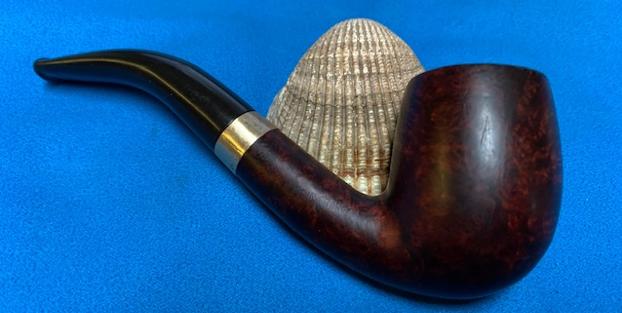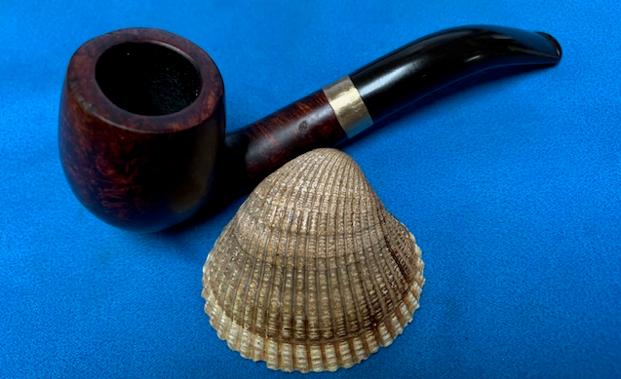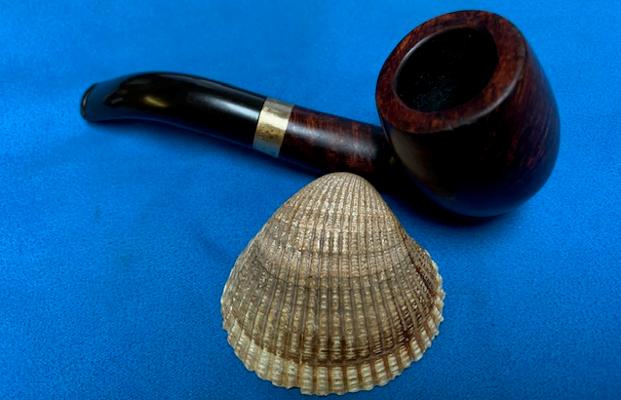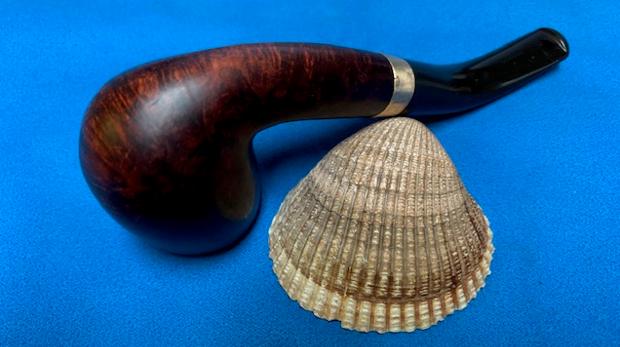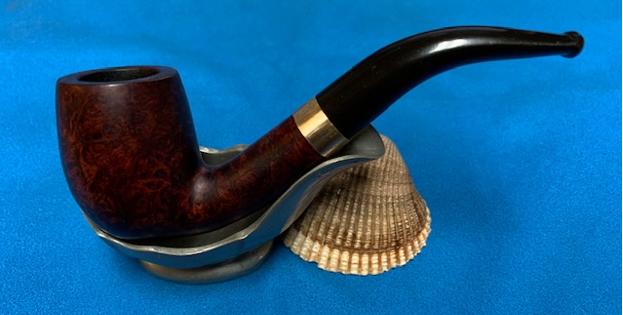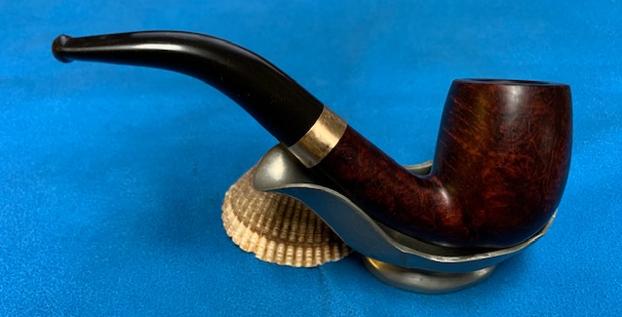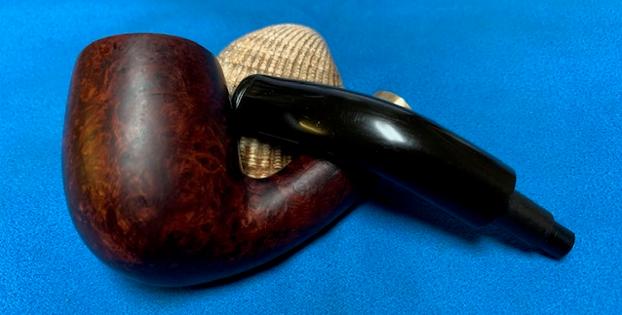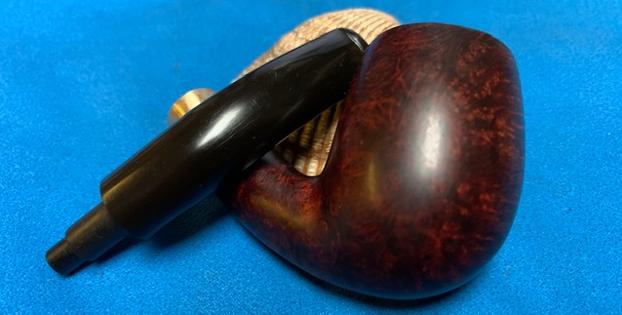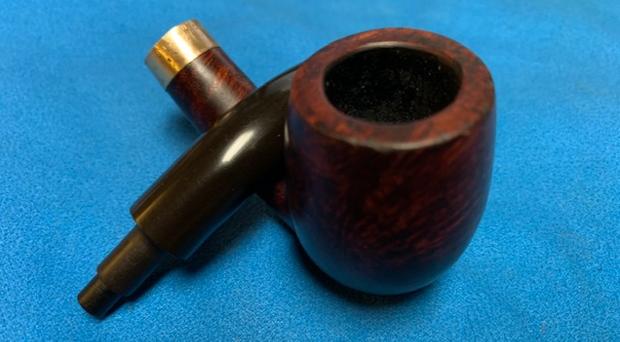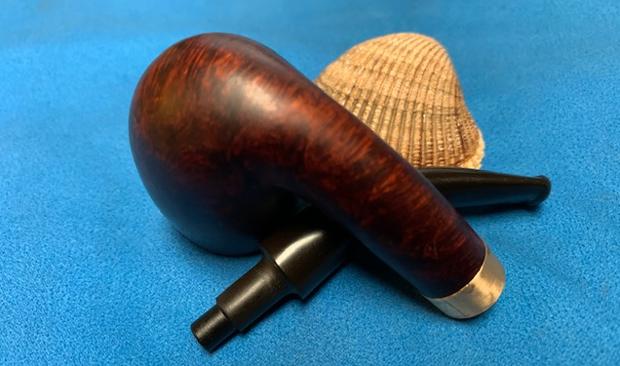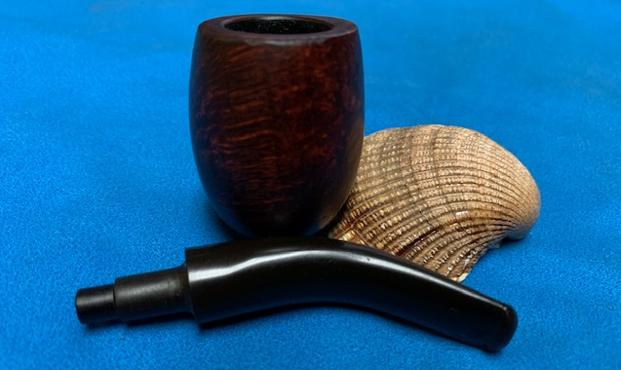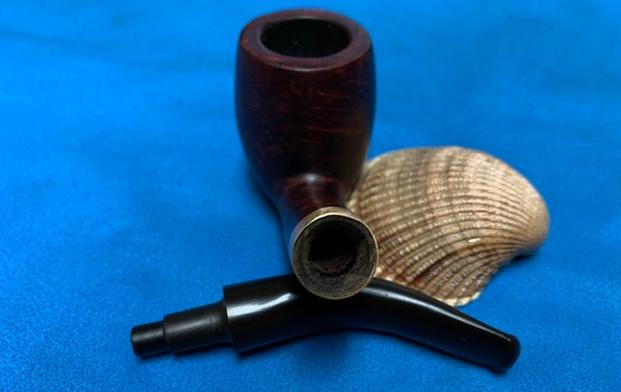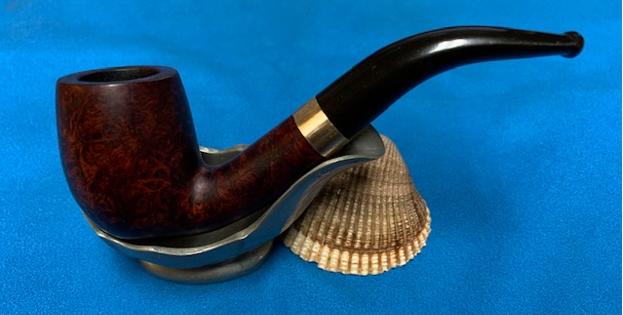Blog by Steve Laug
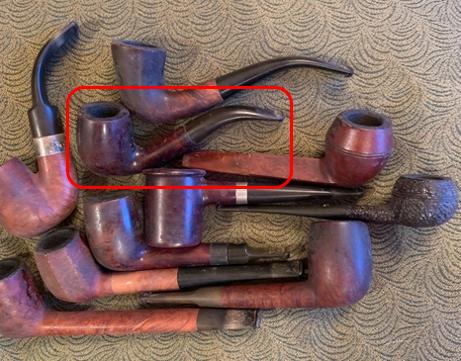 I have finished restoring all of the Barclay-Rex pipes in the collection of pipes that we purchased from the older gentleman. He sent me the photos and I was amazed at what I saw. You have seen many of the pipes that he had. These included Dunhill, BBB, Orlik, Barclay Rex, a cased Ben Wade, an H. Simmons all briar, Hardcastles and some Meerschaums. There were also some assorted others that I will get to in the days ahead. It was a great collection.
I have finished restoring all of the Barclay-Rex pipes in the collection of pipes that we purchased from the older gentleman. He sent me the photos and I was amazed at what I saw. You have seen many of the pipes that he had. These included Dunhill, BBB, Orlik, Barclay Rex, a cased Ben Wade, an H. Simmons all briar, Hardcastles and some Meerschaums. There were also some assorted others that I will get to in the days ahead. It was a great collection.
Now it was time to work on some of the single pipes that he had. The next one of these is a beautiful Bent Billiard that is stamped Strand in an oval on the left side of the shank. On the right side it is stamped Made in France. The stamping is faint but readable. It is a nice little Bent Billiard with an older style stem. It appears to have had a band on the shank originally but that had disappeared. There is no crack so it was probably just decorative. I have drawn a red box around the pipe in the above photo to identify it for you.
Jeff took some photos of French Made Strand Bent Billiard before he worked his magic in cleaning up the pipe. It is a an interesting pipe with a lot of potential and what appears to be some great grain under the grime and debris of the years.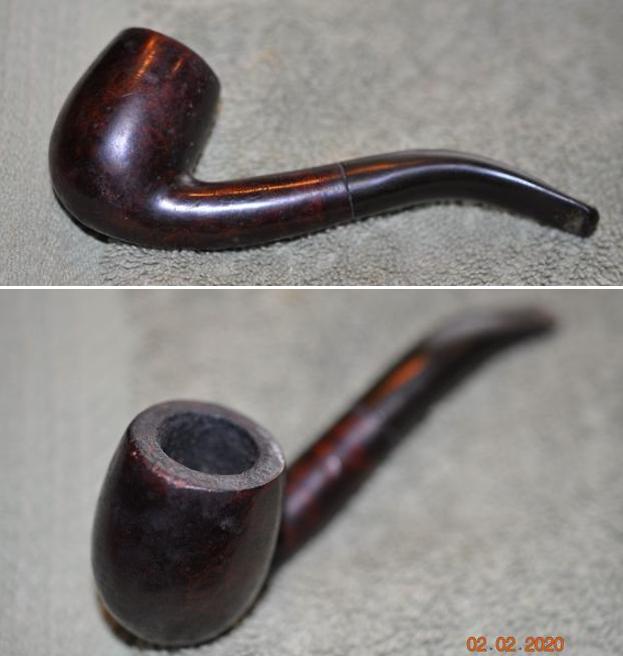 Jeff took photos of the bowl, rim top to show the thickness of the cake in the bowl and the thick lava on the rim top. The rim top and both inner and outer edges looked good. But if there are issues it will become clearer after the clean up. He took photos of the top and underside of the vulcanite stem showing the oxidation, calcification, tooth marks, chatter and wear on the stem and button.
Jeff took photos of the bowl, rim top to show the thickness of the cake in the bowl and the thick lava on the rim top. The rim top and both inner and outer edges looked good. But if there are issues it will become clearer after the clean up. He took photos of the top and underside of the vulcanite stem showing the oxidation, calcification, tooth marks, chatter and wear on the stem and button.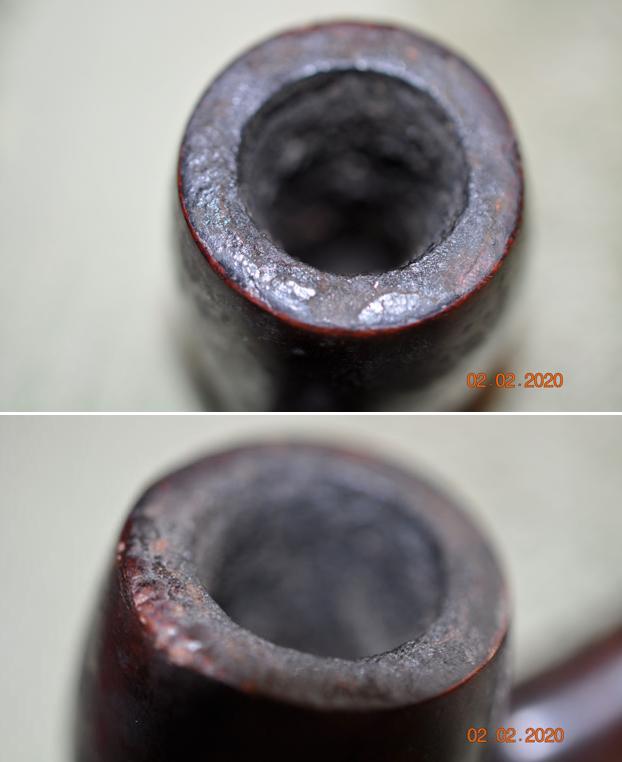
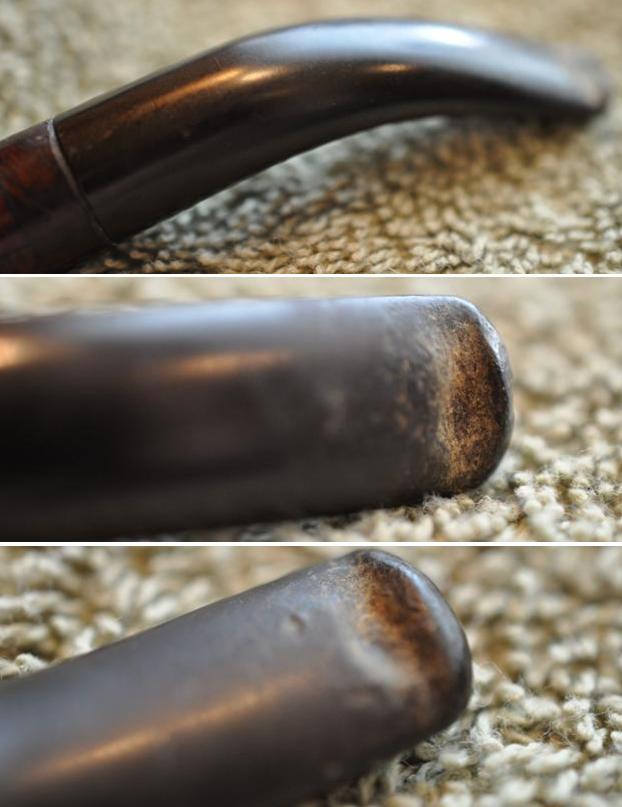 Jeff took photos of the sides and heel of the bowl to show the condition of the briar. You can see the beautiful shape of the bowl even through the dirt and debris of many years.
Jeff took photos of the sides and heel of the bowl to show the condition of the briar. You can see the beautiful shape of the bowl even through the dirt and debris of many years.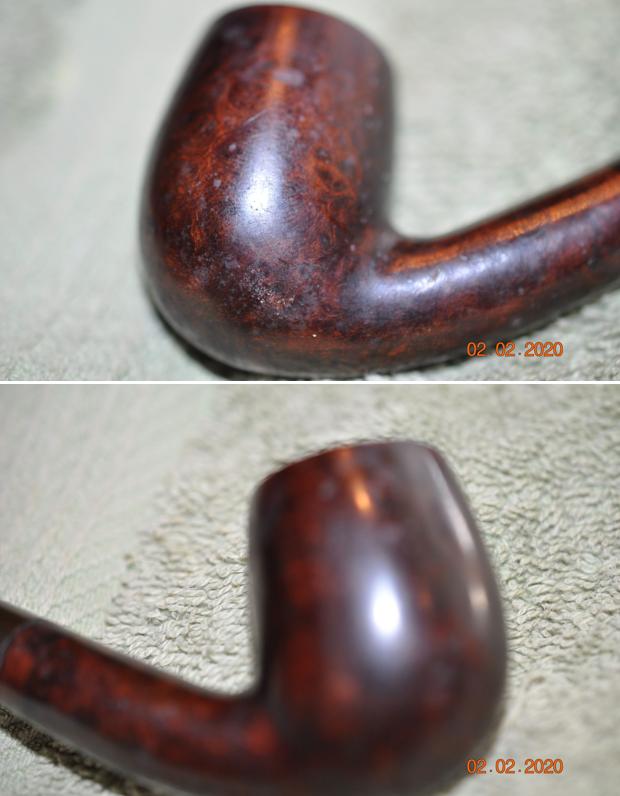
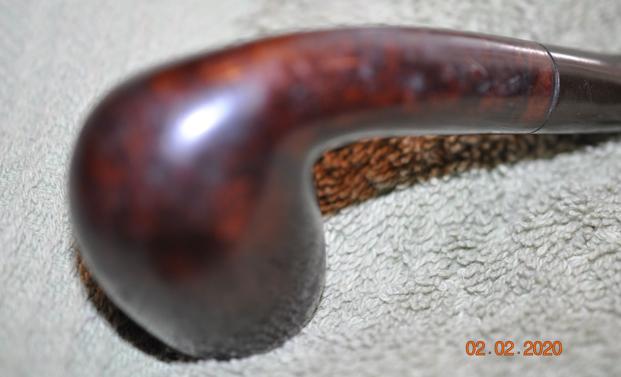 Jeff took a photo of the stamping on the left side of the shank to capture that it is faint but readable.
Jeff took a photo of the stamping on the left side of the shank to capture that it is faint but readable. 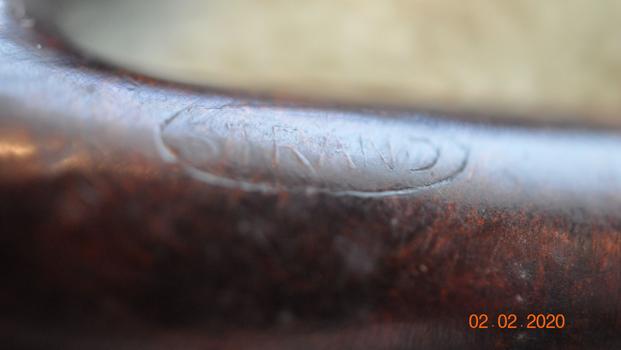 As is my habit I turned to Pipephil’s site but there was no information on the brand that I could find there in the several spots that I looked at.
As is my habit I turned to Pipephil’s site but there was no information on the brand that I could find there in the several spots that I looked at.
I turned to Pipedia as well to check and came up empty there as well. There was no listing for the Strand brand or tie to other French made pipes.
I had one more possible link to check so I turned to my copy of Who Made That Pipe to see if there were any listings for the Strand line. Here is what I found. The Strand pipe had three possible makers – Comoy’s, L. Orlik and L&HS. The first two were noted as English pipemakers and the third I believe should read LH Stern is an American pipemaker. Since the pipe was made in France it pretty well removed LH Stern and Orlik from the running. The only company who made pipes both in England and France was Comoy’s. I think I may have found the link to who made this pipe.![]() With the information from Who Made That Pipe it seems that the pipe was made by Comoy’s and it certainly showed similarities to that brand. The old gentleman that we bought the pipes from intimated that he purchased it at the Manhattan Barclay-Rex store. I was unable to pin down any information regarding the date this pipe was made. Now it was time to work on the pipe.
With the information from Who Made That Pipe it seems that the pipe was made by Comoy’s and it certainly showed similarities to that brand. The old gentleman that we bought the pipes from intimated that he purchased it at the Manhattan Barclay-Rex store. I was unable to pin down any information regarding the date this pipe was made. Now it was time to work on the pipe.
Jeff carefully cleaned the pipe. He reamed it with a PipNet pipe reamer and then cleaned up the reaming with a Savinelli Fitsall Pipe Knife. He scrubbed out the internals of the shank, stem and shank extension with alcohol, pipe cleaners and cotton swabs until the pipe was clean. He scrubbed the exterior of the bowl with Murphy’s Oil Soap and a tooth brush to remove the grime and grit on the briar and lava on the rim top. The finish looks much better and has a deep richness in the colour that highlights the dimensions of the grain. The rim top looked good with some darkening on the top and damage to the back outer edge of the bowl. He soaked the stem in Briarville’s Pipe Stem Deoxidizer and scrubbed it with Soft Scrub to remove the remnants of oxidation. When the pipe arrived here in Vancouver I was amazed it looked so good. Here are some photos of what I saw. 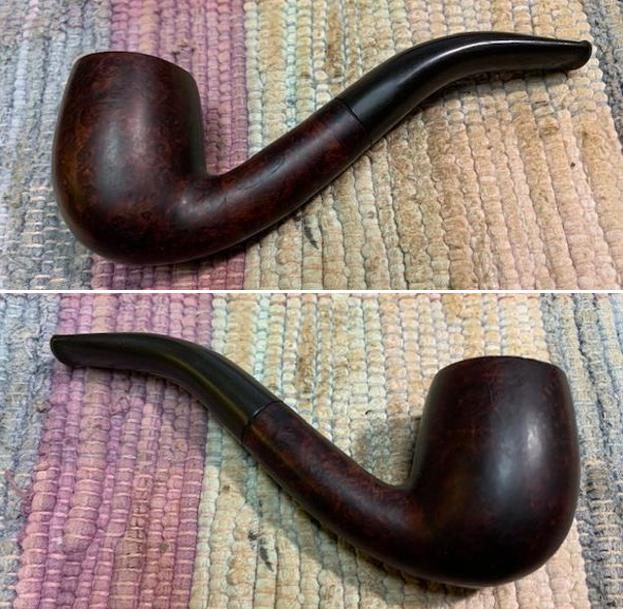
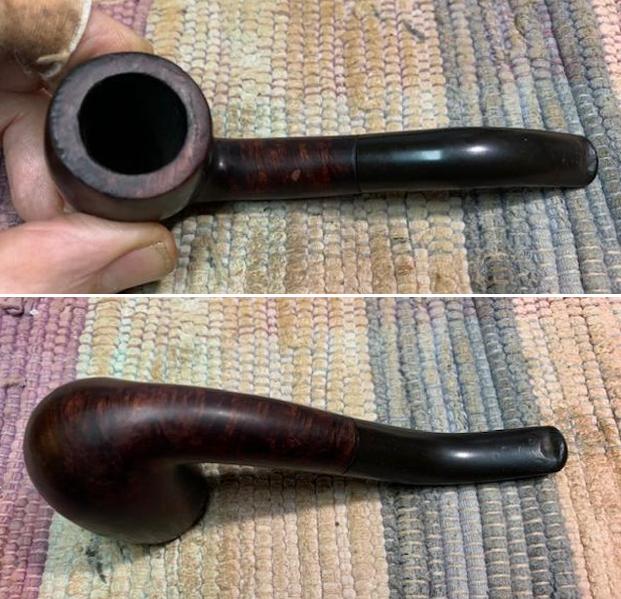 I took some close up photos of the rim top and the stem surface. The top and inner and outer edge of the rim look very good. There was light damage on the inner edge of the bowl. The stem was older Hard Rubber and had deep tooth marks just ahead of the button.
I took some close up photos of the rim top and the stem surface. The top and inner and outer edge of the rim look very good. There was light damage on the inner edge of the bowl. The stem was older Hard Rubber and had deep tooth marks just ahead of the button. 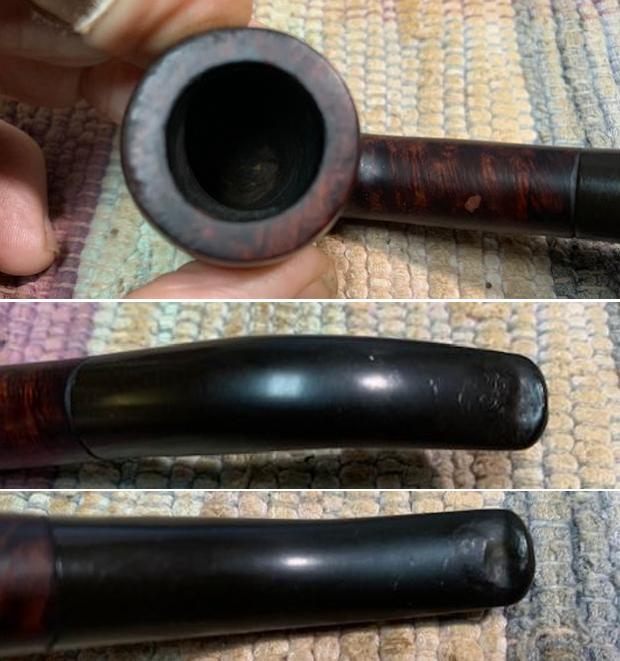 I took a picture of the stamping on the left side of the shank and it was faint but readable as noted above.
I took a picture of the stamping on the left side of the shank and it was faint but readable as noted above. I removed the stem from the shank and took a photo of the parts of the pipe.
I removed the stem from the shank and took a photo of the parts of the pipe. 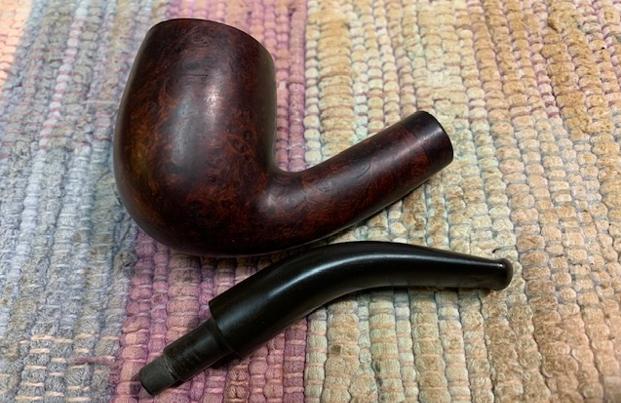 I started my work on the pipe by examining the shank end. There is a clear demarcation on the shank end that tells me that the pipe originally had a band. I examined the shank end and externals and there was no cracking so the band had to have been ornamental. With the age of the pipe estimated to the 1930s or 1940s I was pretty sure that the band would have been a standard decoration. I went through my bands and found a nice 14K gold band that would work well. It was deeper than I needed so I would need to reduce that to get a fit like the previous band. I heated the band with a lighter and pressed it onto the shank to get a fit that covered the line left on the shank.
I started my work on the pipe by examining the shank end. There is a clear demarcation on the shank end that tells me that the pipe originally had a band. I examined the shank end and externals and there was no cracking so the band had to have been ornamental. With the age of the pipe estimated to the 1930s or 1940s I was pretty sure that the band would have been a standard decoration. I went through my bands and found a nice 14K gold band that would work well. It was deeper than I needed so I would need to reduce that to get a fit like the previous band. I heated the band with a lighter and pressed it onto the shank to get a fit that covered the line left on the shank.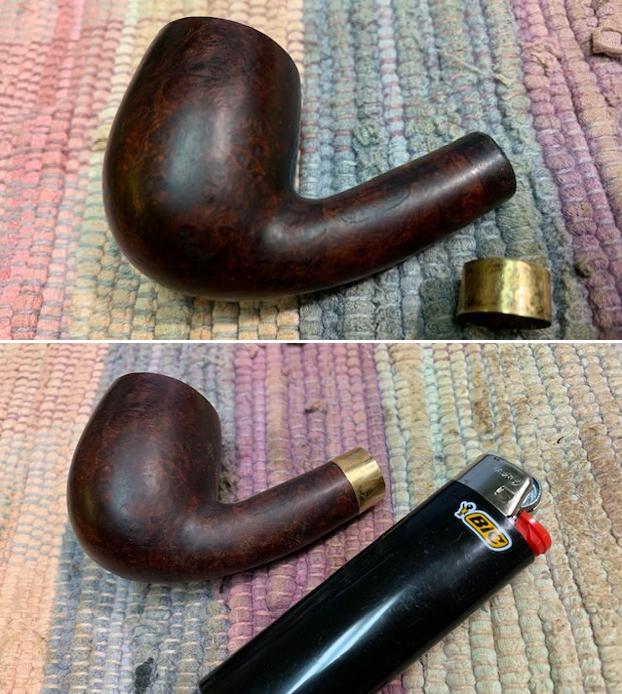 I took a photo of the band on the shank to show the extra band depth that I would need to remove before the fit was proper. I used a topping board and 220 grit sandpaper to carefully remove the excess band depth. I cleaned up the sharp edge with micromesh sanding pads. I was careful to not damage the stamping on the band. Once I finished I was pretty happy with the fit.
I took a photo of the band on the shank to show the extra band depth that I would need to remove before the fit was proper. I used a topping board and 220 grit sandpaper to carefully remove the excess band depth. I cleaned up the sharp edge with micromesh sanding pads. I was careful to not damage the stamping on the band. Once I finished I was pretty happy with the fit.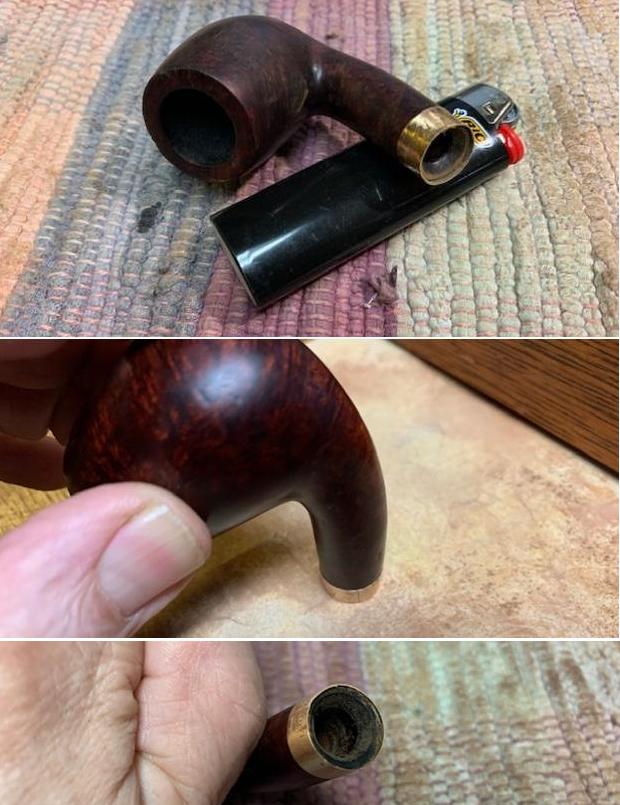 I sanded the tenon a little to get a snug fit in the shank and put the stem in place. I took photos of the pipe with the new band. Lots of polishing to do on all the parts but it looked good.
I sanded the tenon a little to get a snug fit in the shank and put the stem in place. I took photos of the pipe with the new band. Lots of polishing to do on all the parts but it looked good.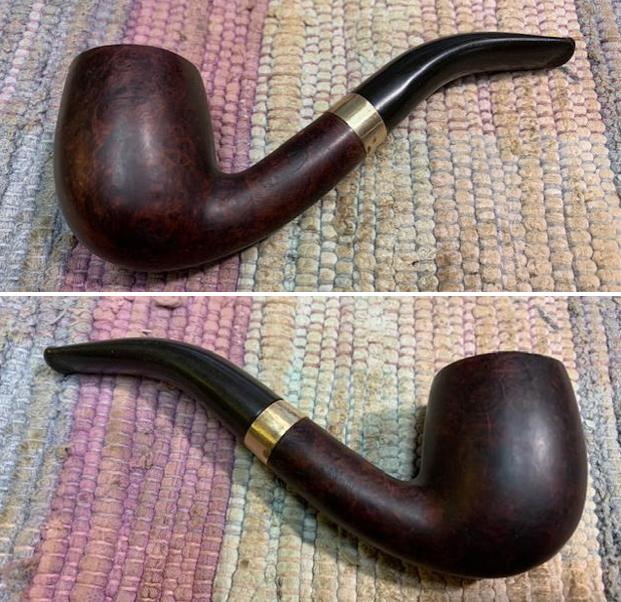
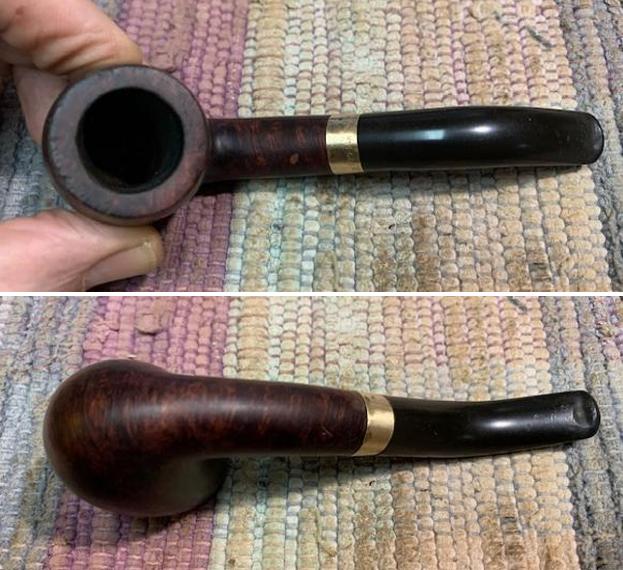 I used a folded piece of 220 grit sandpaper to smooth out the damage on the rim edge and clean up the marks on the rim top.
I used a folded piece of 220 grit sandpaper to smooth out the damage on the rim edge and clean up the marks on the rim top.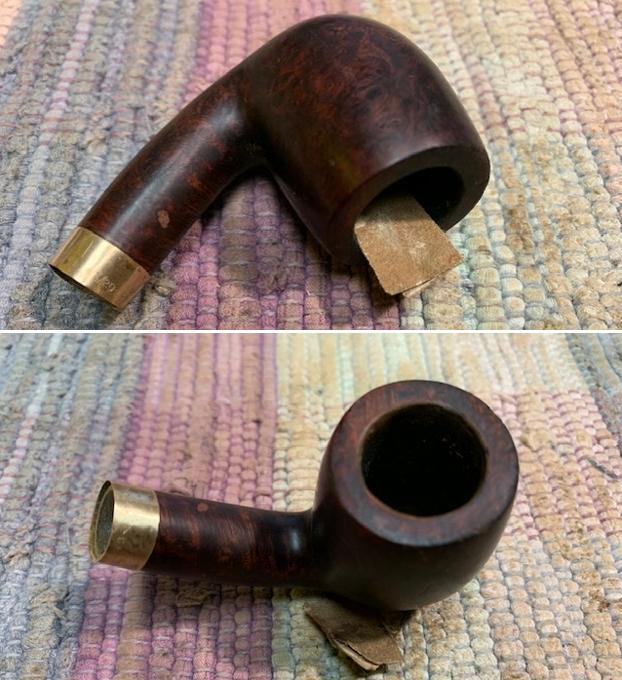 I polished the briar with micromesh sanding pads – dry sanding with 1500-12000 grit pads. I wiped the briar down after each grit with a damp cloth. The grain began to really stand out.
I polished the briar with micromesh sanding pads – dry sanding with 1500-12000 grit pads. I wiped the briar down after each grit with a damp cloth. The grain began to really stand out.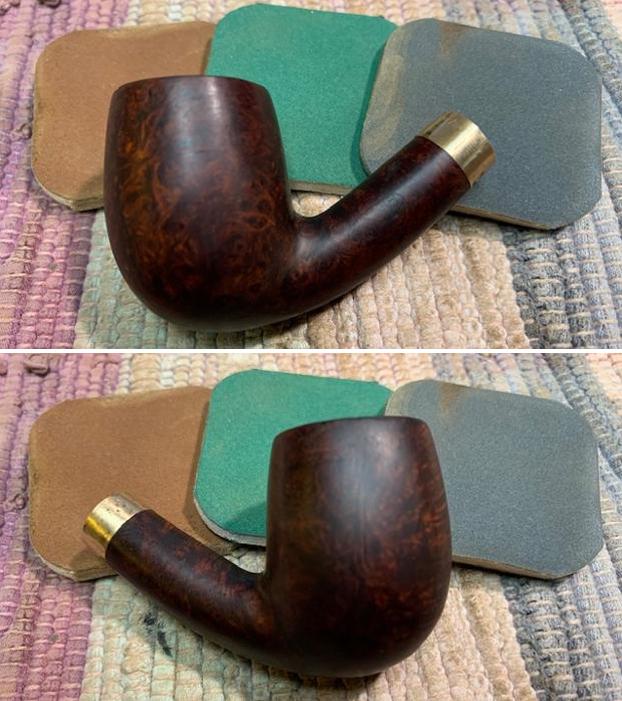
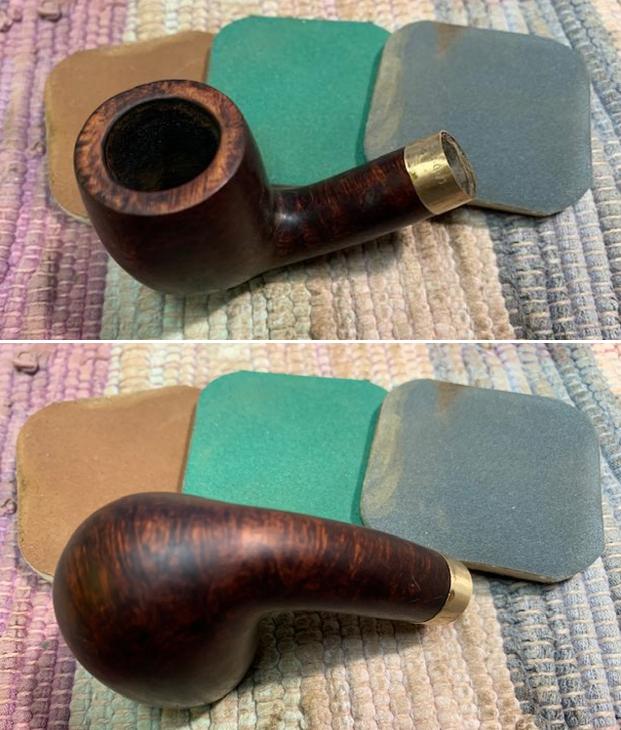
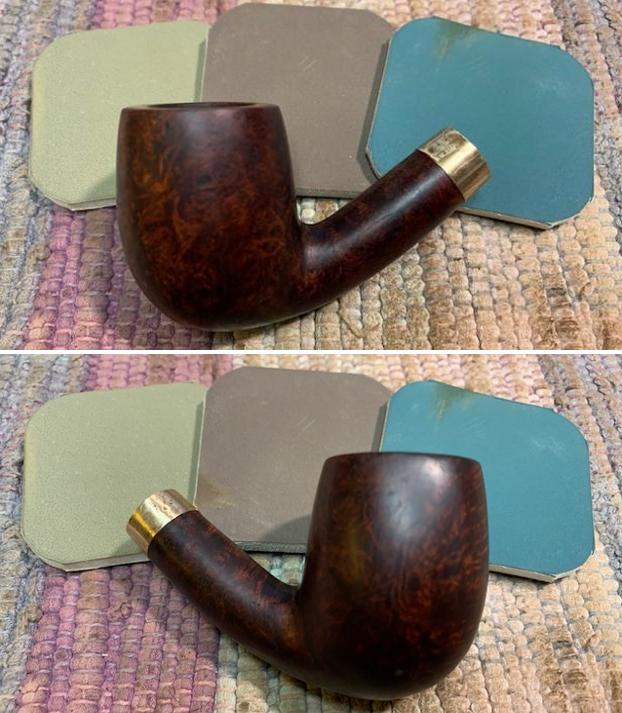
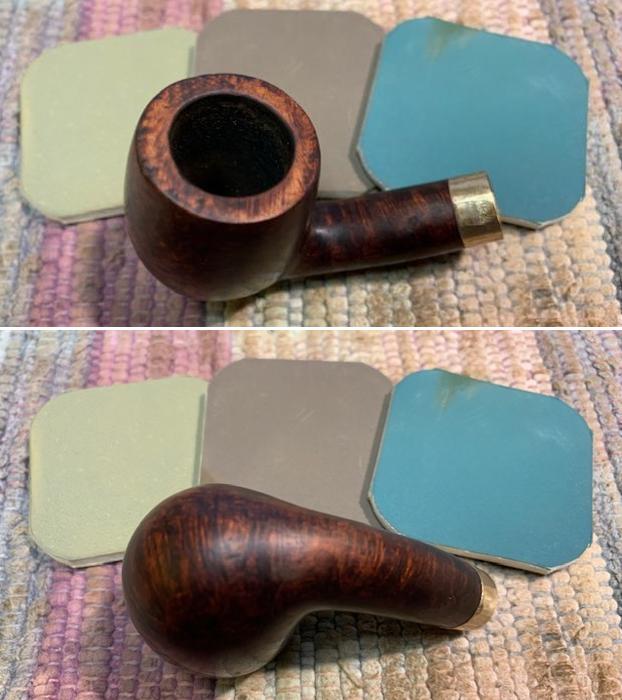
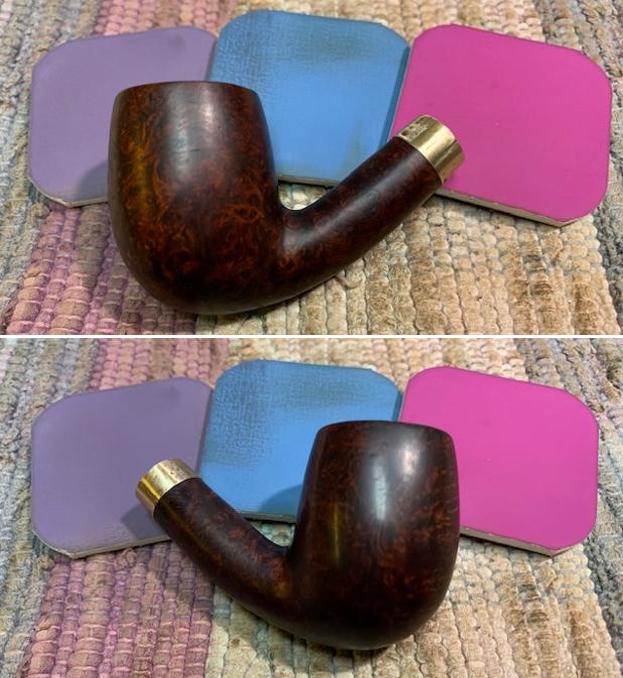
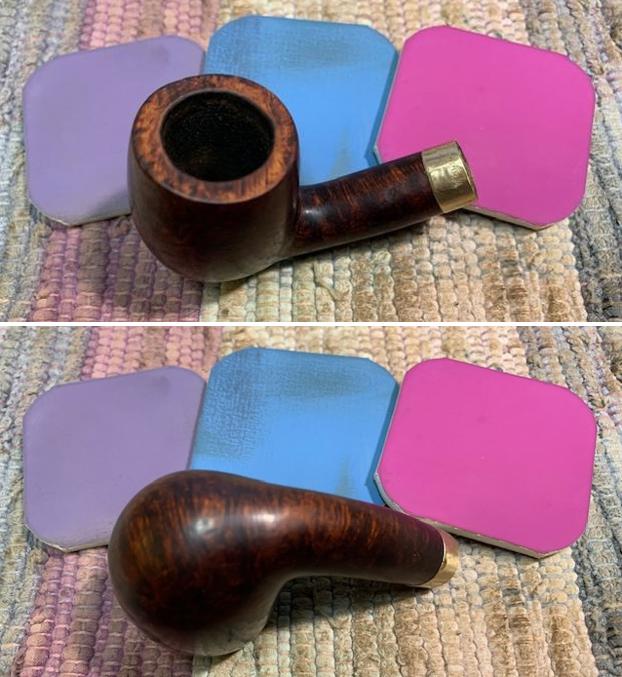 I worked some Before & After Restoration Balm into the surface of the bowl and shank with my fingertips to clean, enliven and protect the briar. I let the balm sit for 15 minutes and then buffed with a cotton cloth to raise the shine. I polished the band with a jeweler’s cloth. The photos show the bowl at this point in the restoration process.
I worked some Before & After Restoration Balm into the surface of the bowl and shank with my fingertips to clean, enliven and protect the briar. I let the balm sit for 15 minutes and then buffed with a cotton cloth to raise the shine. I polished the band with a jeweler’s cloth. The photos show the bowl at this point in the restoration process. 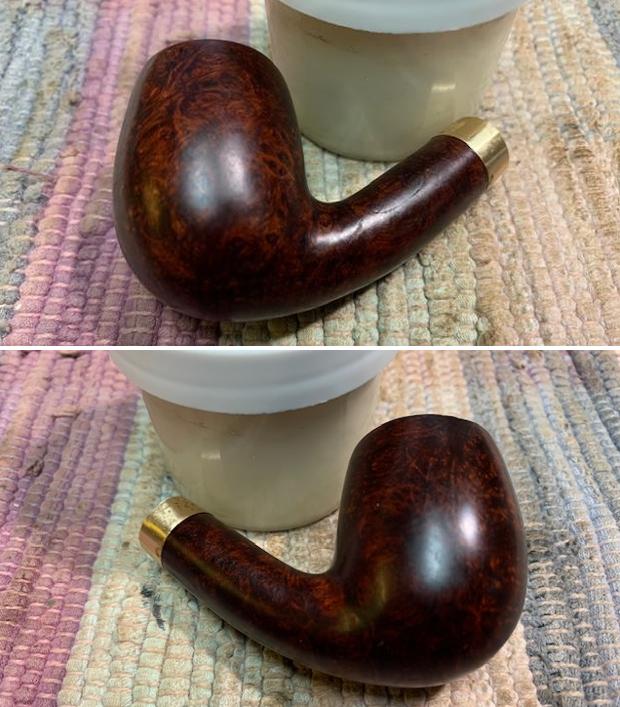
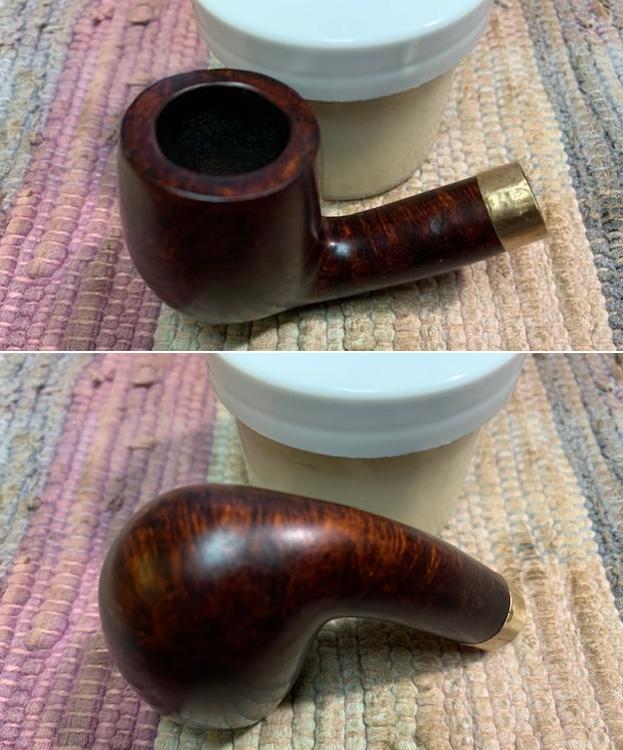
 I set the bowl aside and turned my attention to the stem. I “painted” it with the flame of a Bic lighter to lift the tooth dents in the vulcanite on both sides. I raised them significantly but I am very careful with burning older hard rubber. It is easy to char the rubber then you have more issues to deal with! When I had finished I filled in the remaining dents with clear CA glue. Once it cured I sanded it with a folded piece of 220 grit sandpaper to blend them in the rest of the stem surface. I started polishing the stem with 400 grit wet dry sandpaper.
I set the bowl aside and turned my attention to the stem. I “painted” it with the flame of a Bic lighter to lift the tooth dents in the vulcanite on both sides. I raised them significantly but I am very careful with burning older hard rubber. It is easy to char the rubber then you have more issues to deal with! When I had finished I filled in the remaining dents with clear CA glue. Once it cured I sanded it with a folded piece of 220 grit sandpaper to blend them in the rest of the stem surface. I started polishing the stem with 400 grit wet dry sandpaper. 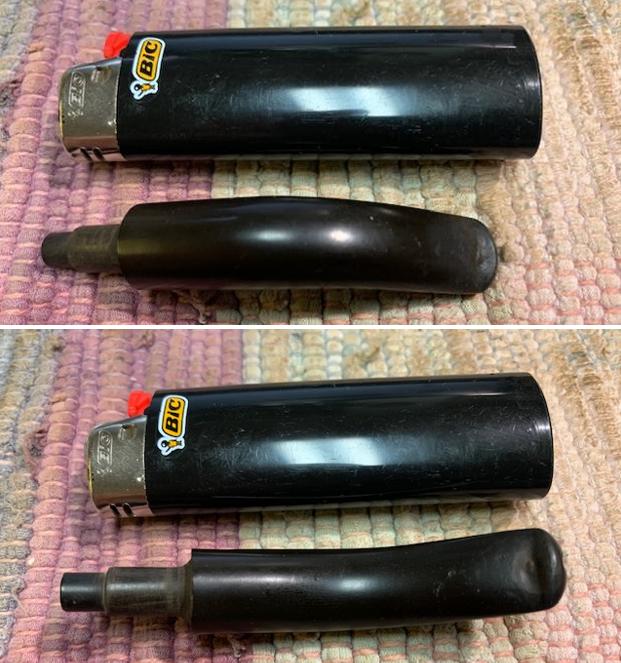
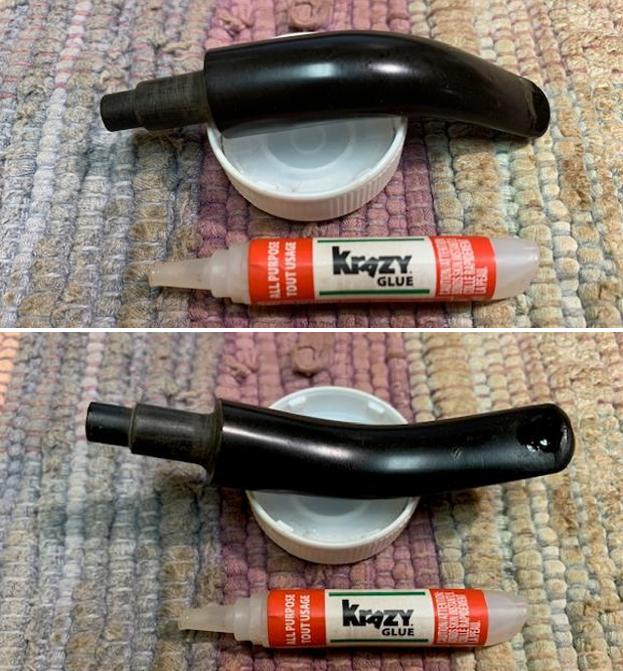
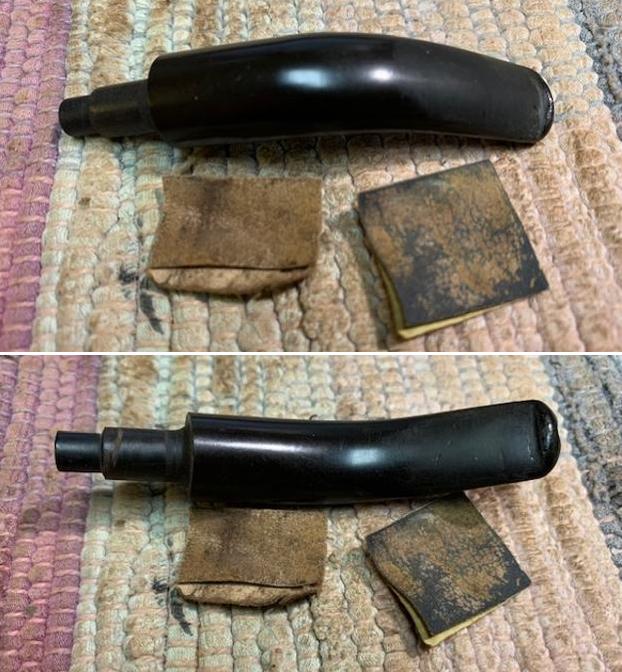 I polished the stem with micromesh sanding pads – dry sanding with 1500-12000 grit sanding pads. I wiped it down after each sanding pad with Obsidian Oil. I polished it with Before & After Pipe Stem Polish – both Fine and Extra Fine. I gave it a final coat of Obsidian Oil.
I polished the stem with micromesh sanding pads – dry sanding with 1500-12000 grit sanding pads. I wiped it down after each sanding pad with Obsidian Oil. I polished it with Before & After Pipe Stem Polish – both Fine and Extra Fine. I gave it a final coat of Obsidian Oil.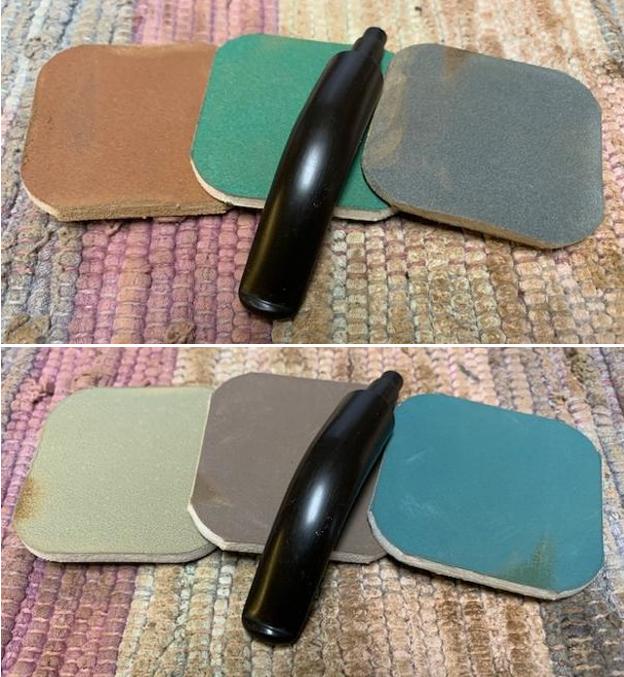
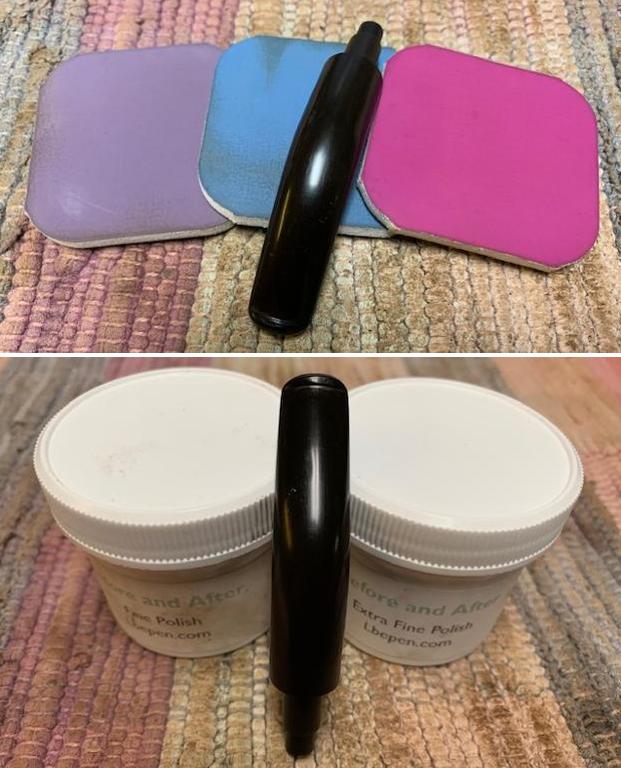 With the bowl and the stem finished I put the beautiful French Made Comoy’s Strand Bent Billiard back together and buffed it on the wheel using Blue Diamond to give it a shine. I gave the bowl and the stem multiple coats of carnauba wax on the wheel. I buffed it with a clean buffing pad to raise the shine. I hand buffed it with a microfiber cloth to deepen the shine. It really is a great looking sandblast. The dimensions of the pipe are – Length: 5 inches, Height: 1 ¾ inch, Outside diameter of the bowl: 1 inches, Chamber diameter: ¾ of an inch. The weight of this large pipe is 1.13 ounces /32 grams. This Strand Bent Billiard is another great find in this collection. I try to use the same prop with the pipes I photograph to give a sense of size and proportion of the pipe. You can see from the dimensions given above this is a petite pipe that makes this small shell seem quite large. It is much more beautiful in person than these photos can capture. I will be putting it on the rebornpipes store soon. If you would like to add it to your collection let me know. This is another pipe that has the possibility of transporting the pipe man or woman back to a slower paced time in history where you can enjoy a respite. Thanks for walking through the restoration with me.
With the bowl and the stem finished I put the beautiful French Made Comoy’s Strand Bent Billiard back together and buffed it on the wheel using Blue Diamond to give it a shine. I gave the bowl and the stem multiple coats of carnauba wax on the wheel. I buffed it with a clean buffing pad to raise the shine. I hand buffed it with a microfiber cloth to deepen the shine. It really is a great looking sandblast. The dimensions of the pipe are – Length: 5 inches, Height: 1 ¾ inch, Outside diameter of the bowl: 1 inches, Chamber diameter: ¾ of an inch. The weight of this large pipe is 1.13 ounces /32 grams. This Strand Bent Billiard is another great find in this collection. I try to use the same prop with the pipes I photograph to give a sense of size and proportion of the pipe. You can see from the dimensions given above this is a petite pipe that makes this small shell seem quite large. It is much more beautiful in person than these photos can capture. I will be putting it on the rebornpipes store soon. If you would like to add it to your collection let me know. This is another pipe that has the possibility of transporting the pipe man or woman back to a slower paced time in history where you can enjoy a respite. Thanks for walking through the restoration with me.